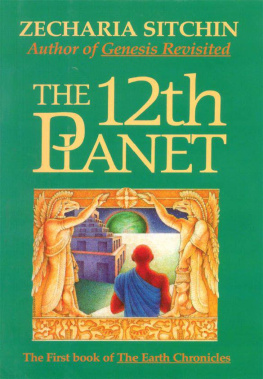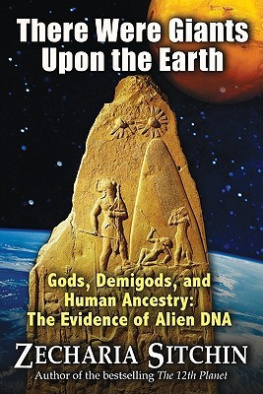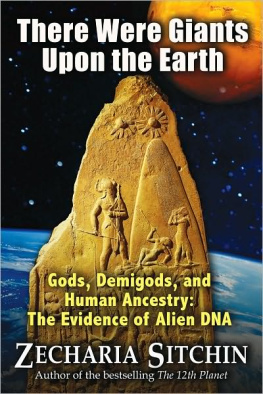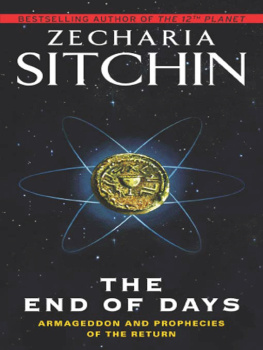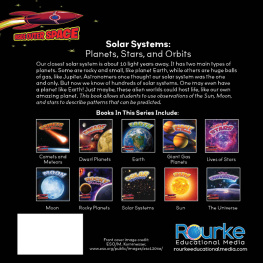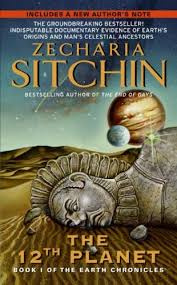
Praise for The Earth Chronicles series
"Exciting ... credible ... most provocative and compelling."
Library Journal
"A dazzling performance ... Sitchin is a zealous investigator."
Kirkus Reviews
"Several factors make Sitchin's well-referenced works outstandingly different from all others that present this central theme. For one, his linguistic skills, which include not only several modern languages that make it possible for him to consult other scholars' works in their original tongues, but the ancient Sumerian, Egyptian, Hebrew, and other languages of antiquity as well.
"The devotion of thirty years to academic search and personal investigation before publishing resulted in unusual thoroughness, perspective, and modifications where need arose. The author's pursuit of the earliest available texts and artifacts also made possible the wealth of photos and line drawings made for his books from tablets, monuments, murals, pottery, seals, etc. Used generously throughout, they provide vital visual evidence.... While the author does not pretend to solve all the puzzles that have kept intensive researchers baffled for well over one hundred years, he has provided some new clues."
Rosemary Decker, historian and researcher
ACKNOWLEDGMENT S
The author wishes to express his gratitude to the many scholars who, over a span of more than a century, have uncovered, deciphered, translated, and explained the textual and artistic relics of the ancient Near East; and to the many institutions and their staffs by whose excellence and courtesies the texts and pictorial evidence on which this book is based were made available to the author.
The author wishes especially to thank the New York Public Library and its Oriental Division; the Research Library (Reading Room and Oriental Students Room) of the British Museum, London; the Research Library of the Jewish Theological Seminary, New York; and, for pictorial assistance, the Trustees of the British Museum and the Keeper of Assyrian and Egyptian Antiquities; the Director of the Vorderasiatisches Museum, Staatliche Museen, East Berlin; the University Museum, Philadelphia; la Reunion des Muses Nationaux, France (Muse du Louvre); the Curator, Museum of Antiquities, Aleppo; the U.S. National Aeronautics and Space Administration.
CONTENTS
Chapter 1.
Chapter 2.
Chapter 3.
Chapter 4.
Chapter 5.
Chapter 6.
Chapter 7.
Chapter 8.
Chapter 9.
Chapter 10.
Chapter 11.
Chapter 12.
Chapter 13.
Chapter 14.
Chapter 15.
AUTHOR'S NOTE
The prime source for the biblical verses quoted in The Twelfth Planet is the Old Testament in its original Hebrew text. It must be borne in mind that all the translations consultedof which the principal ones are listed at the end of the bookare just that: translations or interpretations. In the final analysis, what counts is what the original Hebrew says.
In the final version quoted in The Twelfth Planet, I have compared the available translations against each other and against the Hebrew source and the parallel Sumerian and Akkadian texts/tales, to come up with what I believe is the most accurate rendering.
The rendering of Sumerian, Assyrian, Babylonian, and Hittite texts has engaged a legion of scholars for more than a century. Decipherment of script and language was followed by transcribing, transliterating, and finally, translating. In many instances, it was possible to choose between differing translations or interpretations only by verifying the much earlier transcriptions and transliterations. In other instances, a late insight by a contemporary scholar could throw new light on an early translation.
The list of sources for Near Eastern texts, given at the end of this book, thus ranges from the oldest to the newest, and is followed by the scholarly publications in which valuable contributions to the understanding of the texts were found.
Z. SITCHIN
Prologue: GENESIS
At a time when our own astronauts have landed on the Moon and our unmanned spacecraft explore other planets, it is no longer impossible to believe that a civilization on another planet more advanced than ours was capable of landing its astronauts on the planet Earth at some time in the past. Indeed, a number of popular writers have speculated that ancient artifacts such as the pyramids and giant stone sculptures must have been fashioned by advanced visitors from another planet.
There is, however, little novelty in such intriguing speculation. Even the ancient peoples themselves believed that superior beings "from the heavens"the ancient godscame down to Earth. What no popular writer on the subject provides is answers. If, indeed, such beings did come to Earth, when did they come, how did they come, from where did they come, and what did they do here during their stay?
What we propose to do is to provide answers to these questions. Using the Old Testament as our anchor, and submitting as evidence nothing but the texts, drawings, and artifacts left us by the ancient peoples of the Near East, we will go beyond the intriguing questions and the provocative suggestions. We will prove that Earth was indeed visited in its past by astronauts from another planet.
We will identify the planet from which these astronauts came.
We will decipher a sophisticated ancient cosmology that explains better than our present sciences how Earth and other parts of the solar system came into being.
We will lay bare ancient reports of a celestial collision, as a result of which an intruding planet was captured into the Sun's orbit, and show that all the ancient religions were based on the knowledge and veneration of this twelfth member of our solar system.
We will prove that this Twelfth Planet was the home planet of the ancient visitors to Earth. We will submit texts and celestial maps dealing with the space flights to Earth, and will establish when and why they came to Earth.
We will describe them, and show how they looked and dressed and ate, glimpse their craft and weapons, follow their activities upon Earth, their loves and jealousies, achievements and struggles. We will unravel the secret of their "immortality."
We will trace the dramatic events that led to the "Creation" of Man, and show the advanced methods by which this was accomplished. We will then follow the tangled relationship of Man and his deities, and throw light on the true meaning of the events passed to us in the tales of the Garden of Eden, the Tower of Babel, the Deluge, the rise of civilization, the three branches of Mankind. We will show how Manendowed by his makers biologically and materiallyended up crowding his gods off Earth.
We will show that Man is not alone and that future generations will have yet another encounter with the bearers of the Kingship of Heaven.
THE ENDLESS BEGINNING
Of the evidence that we have amassed to support our conclusions, exhibit number one is Man himself. In many ways, modern manHomo sapiensis a stranger to Earth.
Ever since Charles Darwin shocked the scholars and theologians of his time with the evidence of evolution, life on Earth has been traced through Man and the primates, mammals, and vertebrates, and backward through ever-lower life forms to the point, billions of years ago, at which life is presumed to have begun.
But having reached these beginnings and having begun to contemplate the probabilities of life elsewhere in our solar system and beyond, the scholars have become uneasy about life on Earth: Somehow, it does not belong here. If it began through a series of spontaneous chemical reactions, why does life on Earth have but a single source, and not a multitude of chance sources? And why does all living matter on Earth contain too little of the chemical elements that abound on Earth, and too much of those that are rare on our planet?
Next page
